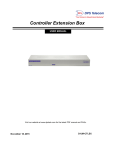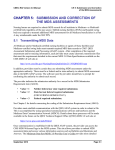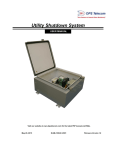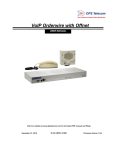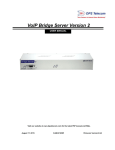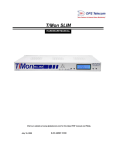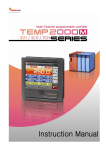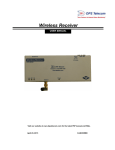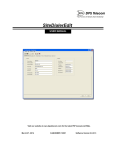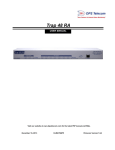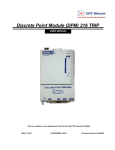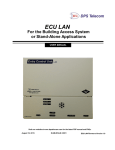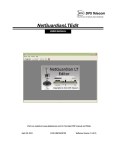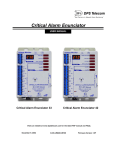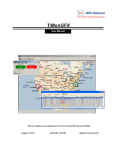Download Building Access Controller 32
Transcript
Building Access 32 USER MANUAL Visit our website at www.dpstelecom.com for the latest PDF manual and FAQs. March 7, 2013 D-UM-BACTL.12002 Revision History March 7, 2013 Added COS Mode, Elevator, Floor Lighting, and Port Customization August 8, 2011 Added "Exit Mode" February 10, 2011 Included instructions for using In-Facility Elevator Mode November 12, 2010 Miscellaneous updates August 27, 2010 Preliminary release This document contains proprietary information which is protected by copyright. All rights are reserved. No part of this document may be photocopied without prior written consent of DPS Telecom. All software and manuals are copyrighted by DPS Telecom. Said software and manuals may not be reproduced, copied, transmitted or used to make a derivative work, by either mechanical, electronic or any other means in whole or in part, without prior written consent from DPS Telecom, except as required by United States copyright laws. © 2011 DPS Telecom Notice The material in this manual is for information purposes and is subject to change without notice. DPS Telecom shall not be liable for errors contained herein or consequential damages in connection with the furnishing, performance, or use of this manual. Contents Visit our w ebsite at w w w .dpstelecom .com for the latest PDF m anual and FAQs 1 Overview: Building Access Controller 32 1 2 Shipping List 2 3 Installation 3 3.1 Tools Needed 3 3.2 Mounting 4 4 BACTL 32 Front Panel 5 4.1 Power Connection (+24VDC) 5 4.2 LAN Connection 6 4.3 Proxy Card Reader Connection 6 4.4 Adjusting Relay Operation 7 5 BACTL 32 Back Panel Craft Port 10 6 Quick Start: How to Connect to the BACTL 32 11 6.1 ...via Craft Port (using TTY Interface) 11 6.2 ...via LAN 13 7 Quick Start: How to Setup BACTL 32 in T/Mon 14 8 Quick Start: Access Web Browser Interface 16 8.1 16 9 Logging on to the BACTL 32 Web Browser (Editing) 17 9.1 System 17 9.2 Edit BAC1 (for Doors 1-16) 19 9.2.1 Customize Port Options 19 9.3 Edit BAC2 (for Doors 17-32) 20 9.4 Logon 20 9.5 Ethernet 21 9.6 Filter IPA 22 9.7 Ports 23 9.8 Date and Time 24 9.9 NVRAM 25 9.10 Reboot 25 9.11 Web Browser (Monitoring) 26 9.11.1 Mon BAC1 26 9.11.2 Mon BAC2 26 10 In-Facility Broadcast 27 10.1 Elevator Mode 30 10.2 Exit Mode 33 11 Front and Back Panel LEDs 34 12 Upgrading Firmware via COM Port 35 13 Technical Support 36 14 End User License Agreement 37 1 1 Overview: Building Access Controller 32 Building Access Controller 32 (BACTL 32) Control up to 32 doors with one unit The Building Access Controller 32 (BACTL 32) interfaces to your door controllers and alarms, proxy card readers, and T/Mon Alarm Master. When someone waves a proxy card in front of the reader, the entry code is sent to the BACTL 32. The BACTL 32 then authenticates the code to see if it is valid for that specific door at that time. While entry decisions are made by the Building Access Controller 32, the T/Mon is notified of entry activities and logs any intrusion alarms. The T/Mon is also responsible for provisioning the BACTL 32 with valid access codes. Building Access Controller 32 features Controls up to 32 entry points Supports proxy card entry Easy hookup via standard RJ45 connector (1 per door) LAN communication with T/Mon Relay locks and unlocks each door Alarm point monitors each door for open and close 2 2 Shipping List Please make sure all of the following items are included with your Building Access Controller 32. If parts are missing, or if you ever need to order new parts, please refer to the part numbers listed and call DPS Telecom at 1-800-622-3314. Building Access Controller 32 D-PK-BACTL Resource CD User Manual D-UM-BACTL.12002 14 ft. Ethernet Cable D-PR-923-10A-14 3/4-Amp GMT Fuses 2-741-00750-00 Lg. Power Connector (Main Pwr) 2-820-00862-02 x2 6 ft. DB9M-DB9F Download Cable D-PR-045-10A-04 x2 19" Rack Ears D-CS-325-10A-00 23" Rack ears D-CS-325-10A-01 3 x4 x2 Four 3/8" Ear Screws 1-000-60375-05 Two Metric Rack Screws 2-000-80750-03 x2 Two Standard Rack Screws 1-000-12500-06 Pads 2-0150-00030-00 x 32 32 Diodes 2-302-04002-00 3 3.1 Installation Tools Needed To install the Building Access Controller 32, you'll need the following tools: Phillips No. 2 Screwdriver PC with terminal emulator, such as HyperTerminal Small Standard No. 2 Screwdriver 4 3.2 Mounting The Building Access Controller 32 can be flush or rear-mounted The Building Access Controller 32 mounts in a 19" rack or a 23" rack using the provided rack ears for each size. Two rack ear locations are available. Attach the appropriate rack ears in the flush-mount or rear-mount locations, as shown above. Note: Rack ears can be rotated 90° for wall mounting or 180º for other mounting options (not shown). Fig. 4.2 Fig. 4.3 5 4 BACTL 32 Front Panel Building Access Controller 32 panel connections 4.1 Power Connection (+24VDC) The Building Access Controller 32 is powered by a single terminal barrier plug power connector. To connect the Building Access Controller 32 to a power supply, follow these steps: 1. Always use safe power practices when making power connections. Be sure to remove fuses from the fuse distribution panel, as well as the back of the Building Access Controller 32, before making your power connections. 2. Use the grounding lug to connect the unit to earth ground. The grounding lug is next to the symbol . Insert the eyelet of the earth ground cable between the two bolts on the grounding lug (Ground cable not included). 3. Insert a battery ground into the power connector plug's right terminal and tighten the screw; then insert a battery line to the plug's left terminal and tighten its screw. 4. Insert a fuse into the fuse distribution panel and measure voltage. The voltmeter should read between+18 and +30VDC. 5. The power plug can be inserted into the power connector only one way to ensure the correct polarity. Note that the positive voltage terminal is on the left and the GND terminal is on the right. 6. Insert fuse into the Power fuse slot. The power LED should be lit green. If the LED is off, the power connection may be reversed. To confirm that power is correctly connected, the front panel LEDs will flash RED and GREEN, indicating that the firmware is booting up. 6 4.2 LAN Connection To connect the Building Access Controller 32 to LAN, insert a standard RJ45 Ethernet cable into the 10/100BaseT Ethernet port. If the LAN connection is OK, the LNK LED will light SOLID GREEN. 4.3 Proxy Card Reader Connection The Building Access Controller 32 uses RJ45 to open-end cables to connect to your door sensors, proxy card readers, and door controller. Below is a topology drawing with pinouts used when connecting these devices. Pin Signal 1 NO/NC* 2 CO 3 DAT-0 4 GND 5 GND 6 DAT-1 7 ALM 8 RTN *see "Adjusting Relay Operation" Open-end 7 ! Hot Tip! DPS Telecom suggests placing a protection diode across the power supply output if utilizing the same power supply to power both the door strike and RFID access card reader. This will protect the power supply from flyback from the door strike. We have included a 1N4002 (DPS Part # 2-302-04002-00) diode in this package to use for this protection. 4.4 Adjusting Relay Operation The BACTL 32 contains 32 control relays used to lock/unlock doors. Each relay has a corresponding jumper that allows switching between the default "Normally Open" (NO) setting and the "Normally Closed" (NC) setting. WARNING: Always observe anti-static precautions whenever opening the unit. To change jumper configurations, remove all of the screws holding the top of the BACTL 32 metal chassis in place. Once the top of the chassis has been freed, carefully remove it and set it aside. On the BACTL 32 circuit board, you will now see 4 groups of 8 relays, for a total of 32. Each relay is labeled on the circuit board from "RLY1" to "RLY32". This 1-32 numbering matches the numbering found in the BACTL 32 software interfaces. Each relay has a shunt located next to it. By default, a jumper will be installed in the NO position of each shunt. Note: Default settings may be different if you ordered a special-configuration BACTL 32. 8 Shunts are locate d ne xt to e ach of the 32 door re lays Top-down vie w of a single door re lay and its corre sponding shunt, with jumpe r in the de fault NO position. To set a relay for "Normally Open" or "Normally Closed" operation, move the jumper to the appropriate location, as shown below. 9 Jumpe r location for "Normally O pe n" (NO ) ope ration Jumpe r location for "Normally Close d" (NC) ope ration Circuit diagram of a BACTL 32 door re lay shunt 10 5 BACTL 32 Back Panel Craft Port Use the back panel craft port to connect the Building Access Controller 32 to a PC to give it an IP address. To use the craft port, connect the included DB9 download cable from your PC's COM port to the craft port. Pinout is shown here for reference, but this is a standard DB9 to DB9. 11 6 Quick Start: How to Connect to the BACTL 32 Most Building Access Controller 32 users find it easiest to give the unit an IP address, subnet and gateway through the front craft port (TTY interface) to start. Once these settings are saved and you reboot the unit, you can access it over LAN to do the rest of your databasing via the Web Browser interface. Alternative option: You can skip the TTY interface by using a LAN crossover cable directly from your PC to the Building Access Controller 32 and access its Web Browser. 6.1 ...via Craft Port (using TTY Interface) 1. The simplest way to connect to the Building Access Controller 32 is over a physical cable connection between your PC's COM port and the unit's craft port. Note: You must be connected via craft port or Telnet to use the TTY interface. Make sure you are using the straight through (1 to 1) Male to Female DB9-DB9 download cable provided with your Building Access Controller 32 to make a craft port connection. We'll be using HyperTerminal to connect to the unit in the following example - however, most terminal-emulating programs should work. To access HyperTerminal using Windows: 2. Click on the Start menu > select Programs > Accessories > Communications > HyperTerminal. 3. At the Connection Description screen, enter a name for this connection. You may also select an icon. The name and icon do not affect your ability to connect to the unit. 4. At the Connect To screen, select Com port you'll be using from the drop down and click OK. (COM1 is the most commonly used.) 5. Select the following COM port options: • Bits per second: 9600 • Data bits: 8 • Parity: None • Stop bits: 1 • Flow control: None 6. When prompted, enter the default password dpstelecom. NOTE: If you don't receive a prompt for the password, check the Com port you are using on your PC and make sure you are using the cable provided. 12 Once connected, you will see a blank, white HyperTerminal screen. Press Enter to activate the configuration menu. Additional cables can be ordered from DPS Telecom: Part number D-PR-045-10A-04 7. The Building Access Controller 32's main menu will appear. Type C for C)onfig, then E for E) thernet. Configure the unit's IP address, subnet mask, and default gateway. 8. ESC to the main menu. When asked if you'd like to save your changes, type Y for Y)es. Reboot the Building Access Controller 32 to save its new configuration. Be sure to change the IP of your computer back to one that operates on your network. Now you're ready to do the rest of your configuration via LAN. Plug your LAN cable into the Building Access Controller 32 and see Section "Logging On to the BACTL 32" to continue databasing using the Web Browser. 13 6.2 ...via LAN Connection through Ethernet port To connect to the Building Access Controller 32 via LAN, all you need is the unit's IP address (Default IP address is 192.168.1.100). If you DON'T have LAN, but DO have physical access to the Building Access Controller 32, connect using a LAN crossover cable (not included). NOTE: Newer PCs should be able to use a standard straight-through LAN cable and handle the crossover for you. To do this, you will temporarily change your PC's IP address and subnet mask to match the Building Access Controller 32's factory default IP settings. Follow these steps: 1. Get a LAN crossover cable and plug it directly into the Building Access Controller 32's LAN port. 2. Look up your PC's current IP address and subnet mask, and write this information down. 3. Reset your PC's IP address to 192.168.1.200. Contact your IT department if you are unsure how to do this. 4. Reset your PC's subnet mask to 255.255.0.0. You may have to reboot your PC to apply your changes. 5. Once the IP address and subnet mask of your computer coincide with the unit, you can access the Building Access Controller 32 via a Telnet session or via Web browser by using the unit's default IP address of 192.168.1.100. 6. Provision the Building Access Controller 32 with the appropriate information, then change your computer's IP address and subnet mask back to their original settings. Now you're ready to do the rest of your configuration via LAN. Plug your LAN cable into the Building Access Controller 32 and see section "Logging On to the BACTL 32" to continue databasing using the Web Browser. 14 7 Quick Start: How to Setup BACTL 32 in T/Mon In order for the Building Access Controller 32 to communicate with a T/Mon master station, it must be added to the T/Mon database. To define the NetGuardian for BAS, go to the Master menu > Files Maintenance menu > LAN-Based Remotes option. The Net Guardian Definition screen will appear. Fill in the fields with the appropriate information, and be sure to select BAC (Building Access Controller) in the Expansions Modules list box menu. Field Description Site Number 3-digit site number. This number is unique over the entire alarm network. This number is the address field for responders, derived alarms, and labeled controls. Description 41 character description of the site. Site Name 15 character site name. This will be stamped on every event from this BACTL. Password 20 character password. (Only needed if T/MonXM will be managing the proxy ports.) Device Type Indicates that the device is a BACTL. Base Proxy Port Set to 3000 (default) or the same as the BACTL. Expansion Units Enter the number of NetGuardian expansion units you are using. (Only needed if T/MonXM will be managing the proxy ports.) Expansion Modules IP Address / Port Select BAC. Enter the IP address for the unit. This is the address that T/Mon will use to poll the BACTL. Also enter the UDP Port address of the BACTL (must match the BACTL). Dedicated Port If the BACTL reports on a dedicated or Ethernet line (DCP), enter the T/MonXM port number. Base Address The DCP address of the “BAC1” section of a BACTL32. 15 Exp. Addr. #1 The DCP address of the BACTL32 “BAC2” DCP address. Exp. Addr. #2 N/A Dialout Port N/A Phone Polling Type* Polling Interval* Enter the phone number to reach the remote. Select Periodic or Schedule from the default box. Periodic polling polls at the interval specified in minutes in the polling interval field. Schedule sets a defined day and time in the week to poll the unit. If periodic is selected, the cursor will skip to the Polling Interval field. If schedule is selected, the cursor will skip to the scheduled days field. Periodic polling only. 0 to 9999 minutes. 0 = never. The cursor will skip out of edit mode after entering a value. Scheduled Days* Enter the whole number of each hour (24 hour clock) to place a polling call (0-23, where 0 = midnight). Example: 0, 8-16 polls at midnight and every hour from 8 AM to 4 PM. Scheduled Minutes* Enter the whole number of the offset from the hour each call is to be made. (0-59, where 0 = on the hour). Example: 30 polls at half past the hour. This procedure is also located in section M22 of your T/MonXM User Manual. 16 8 Quick Start: Access Web Browser Interface The Building Access Controller 32 features a builtin Web Browser Interface that allows you to manage your monitored doors. The web browser is accessible using most browsers. NOTE: Max # of users allowed to simultaneously access the Building Access Controller 32 via the web is 4. 8.1 Logging on to the BACTL 32 1. To connect to the Building Access Controller 32 from your Web browser, you must know its IP address or domain name if it has been registered with your internal DNS. Enter it in the address bar of your Web browser. It may be helpful to bookmark the logon page to simplify access. 2. After connecting to the unit's IP address, enter your password and click Submit. Note: The factory default password is dpstelecom. 3. In the left frame there is Monitor menu button and an Edit menu button. Most of the software configuration will occur in the Edit menu. The following sections provide detailed information regarding these functions. ! Hot Tip! If the Edit menu does not appear in the left frame after logging on, it means that another station has already logged on as the primary user, or that you don't have the rights to modify parameters. The maximum number of users allowed to simultaneously access the Building Access Controller 32 via Web is four. The primary user is the only user with access to the editing features. Exiting the Web interface without logging out prevents other users from accessing the Editing features, as well. Web sessions are tracked by IP Address and the session will time out after twelve minutes of inactivity. Enter your password to enter the Web Browser Interface 17 9 Web Browser (Editing) 9.1 System In the Edit > System menu, fill in the following fields with the appropriate information to begin configuring your Building Access Controller 32. The Edit > System menu Field Description Name Name of this device, used for your reference. Location Location of this Building Access Controller 32, used for your reference. Contact Contact phone number for the person responsible for this Building Access Controller 32. Serial Number Assigned at the DPS Telecom factory for unique unit identification. DCP Port Enter the DCP Port for this Building Access Controller 32, then select between UDP/TCP. In-Facility Broadcast When checked, the "In-Facility Broadcast" function is active. This is an alternate mode of operation and is not commonly used. (see later section for description) In-Facility UDP Port The UDP port used to broadcast "In-Facility" notices to other BACTL 32 units. This port is also used to listen for incoming broadcasts. Default port is 6000. The number of broadcasts (from 1 to 3) that will be executed for each "In-Facility" notice. In-Facility Send Since broadcasts receive no response, sending more than one broadcast increases Count reliability. Broadcast retries occur within a few seconds of each other. Default send value is 1. Normally Open Door Alarms When checked, all door alarms attached to this Building Access Controller 32 will reverse their polarity from "normally closed" to "normally open". Door Unlock Duration The number of seconds (from 1 to 30) that a door will remain unlocked after a valid electronic entry (manual card swipe or keypad, or remote unlock from T/Mon). 18 In-Facility Time The number of minutes (from 1 to 120) that a user will receive "In-Facility" status after successfully accessing one door in the facility. Each BACTL manages countdowns after receiving a broadcast. Lights-On Time (1-120) The amount of time the lights will remain turned on, once the relay is latched. COS Mode Turn COS Mode ON or OFF. Once an open door alarm goes off, COS Mode will automatically turn off the door alarm as soon as the door is closed. If COS Mode is OFF, the door alarm will not reset until the unit is restarted or the user latches the appropriate relay. Elevator Settings Description ID The Identification number (1-4) of each Building Access Controlled device. IP The IP address of the profile-receiving unit. Port The On-the-Floor Port of the receiving unit. On-the-Floor Port Listening port if BAC32 is controlling the elevator. 19 9.2 Edit BAC1 (for Doors 1-16) The Edit > BAC1 menu Field BAC Unit ID Default (Entry Codes) 9.2.1 Description The DCP address for reporting with T/Mon. You must choose different DCP addresses for BAC1 and BAC2. These entry codes (one per door) will be used if codes have not yet been provisioned by T/Mon. The entry code is the proxy card number. This function is intended to simplify the turn-up process. Customize Port Options To customize the Port Options, click on "Click Here to Customize." The Edit > BAC1 > Port Options menu 20 Field Description ID The Identification number. Depending on the BAC function, select either Normal, Elevator, or Floor Lights. Enter the IP Address of the RTU. Enter the ID of the BAP. Note: The chosen BAP should be connected to the same RTU specified by the IPA. Mode IPA BAP ID Floor 9.3 Specify the Floor number. Edit BAC2 (for Doors 17-32) The "Edit BAC2" menu is identical to the "Edit BAC1" menu, except that it is used to edit Doors 17-32. Refer to the previous section for an explanation of the fields in this menu. 9.4 Logon These settings affect the master password and should be provisioned by the unit's administrator. The Edit > Logon menu Field Description Minimum Length Enter the minimum number of characters required for the device's master password. Password Confirm Password Quiet Logon Enter your custom password. NOTE: Default password is "dpstelecom" Re-type your custom password. No password prompt will appear when creating a Telnet session for accessing the unit. 21 9.5 Ethernet Access the Edit > Ethernet menu allows you to define and configure your network settings. 1. Configure the Building Access Controller 32 ethernet port by clicking on the Ethernet link from the Edit menu. 2. Enter the appropriate information for your ethernet port in the corresponding fields. 3. Click Submit Data to save your configuration settings. The Edit > Ethernet menu Field Description Unit Address IP address of the Building Access Controller 32. Subnet Mask A road sign to the unit telling it whether your packets should stay on your local network or be forwarded somewhere else on a wide area network. Gateway An important parameter if you are on a network that is connected to a wide area network. It tell the unit which machine is the gateway out of your local network. Set to 255.255.255.255 if not using . MAC Address Hardware address of the Building Access Controller 32 (not editable, for reference only). 22 9.6 Filter IPA CAUTION: Changing IPA Filter settings may make the BACTL 32 unit unreachable via LAN. Please take caution and only enable the IPA table after submitting and verifying your other Filter IPA settings. The Filter IPA table allows you to increase the device's network security by allowing or blocking packets from specified IP addresses. It is primarily used for diagnostic purposes and should not be required unless to increase security. Addresses which appear in the table will be processed by the Building Access Controller 32. Defined IP addresses associated with network cameras or the network time server are automatically processed and will not be filtered out by this feature. Broadcast packets of 255.255.255.255 and ARP requests for the Building Access Controller 32 IP address are also not filtered. The Edit > Filter IPA menu 1. From the Edit menu select Filter IPA. 2. A warning prompt will appear. Click OK to continue, or Exit to cancel. 23 Filter IPA warning prompt 3. Once enabled only the IP addresses in the table will be allowed access to the Building Access Controller 32. 4. Select to Enable IPA Table. 5. Enter the IP address of the machine(s) you would like to give access to the Building Access Controller 32. 6. Click Submit to save the configuration settings. ! Hot Tip! WARNINGS Entering a zero in any of the octet fields will declare that part of the octet to be a wildcard. Does not work with networks that assign IP addresses. Use the wildcard field to open an entire subnet. Two Modes: Firewall: Block specific addresses Filter table: only allow specific addresses 9.7 Ports Use the following steps to change the craft port communication settings: 1. Navigate to the Edit menu > Ports screen. 2. You can set the baud rate for the craft port to 300, 1200, 2400, 9600, 19200, 38400, 57600, 115200. (Default Baud is 9600) 3. Under the Wfmt (word format) field, select the appropriate data bits, parity, and stop bits setting to match your terminal emulation software or device connected to the NetGuardian craft port. (Default designation is 8,N,1) 4. Click Submit Data to save the craft port settings. Configure the front panel craft port parameters from the Edit > Ports menu 24 9.8 Date and Time The current date and time can be entered from the Date and Time screen or from an SNMP manager The date is entered in the mm/dd/yyyy format and the time is entered in the hh:mm:ss format. The date and time will need resetting following a power failure or reboot unless your Building Access Controller 32 is equipped with the real-time clock option or network time is enabled. Use the following steps to manually set the system's time and date: 1. From the Edit menu, select Date and Time, see Figure 2.31. 2. Enter the appropriate date, the day of the week, and time. 3. Click Submit Data to save the data and time settings. Use the following steps to manually set the system's time and date: 1. From the Edit menu select Date and Time. 2. Click on the Time Zone drop-down menu and select the appropriate time zone. 3. Put a check next to Observe DST if you are in an area that observes daylight saving. 4. You may also change the server IP Address that the unit syncs with by entering a the appropriate IP address in the Time Server IPA field. 5. If you do not want your Building Access Controller 32 to sync with an NTP server, simply set the Time Server IPA to 255.255.255.255. Note: If Time Server IPA is set to 255.255.255.255, you will be able to manually adjust the date and time. 6. Click Submit Data to save the date and time settings. 25 9.9 NVRAM Your Building Access Controller 32 comes equipped with Non Volatile RAM (NVRAM), which enables the retention of data in the event of power loss. This section allows you to write and initialize the NVRAM. NOTE: Some changes require a reboot of the unit to take effect. 1. From the Edit menu select NVRAM. 2. Select Write to cause the current data in RAM to be written to NVRAM and then verified. 3. Select Initialize to reload factory defaults into NVRAM. DO NOT SELECT THIS OPTION UNLESS YOU WANT TO RE-ENTER ALL OF YOUR CONFIGURATION INFORMATION AGAIN. 4. Select Purge BAC to delete the Building Access profile database downloaded from T/Mon XM. NVRAM enables the NetGuardian to retain data even through a power loss 9.10 Reboot Click on the Reboot link from the Edit menu to reboot the BACTL 32 after writing all changes to NVRAM. Any changes to port settings require a reboot to take effect. The window footer will display the text Reboot Needed if a reboot is necessary to initiate changes. 26 9.11 Web Browser (Monitoring) 9.11.1 Mon BAC1 The Monitor > Mon BAC1 menu gives you an at-a-glance view on the current state of half of your doors (1-16). Select "Monitor > Mon BAC2" to view the other half (17-32). The Door column will read Open or Closed. The In-Facility column will display the minutes remaining (if any) of door alarm suppression. See the "In-Facility Broadcast" section of this manual for details on this function. To unlock a door, click on the Relay drop down menu and select "Mom" for Momentary. The door will remain unlocked for the "Door Unlock Duration" defined in the "Edit >> System" menu. The Monitor > Mon BAC1 menu 9.11.2 Mon BAC2 The "Mon BAC2" menu is identical to the "Mon BAC1" menu, except that it is used to monitor Doors 17-32. Refer to the previous section for an explanation of the fields in this menu. 27 10 In-Facility Broadcast This is an alternate mode of Building Access Controller 32 operation. In most applications, you will have electronic access control (keypad or proximity card reader) installed on every door. However, in certain highdensity applications where it is not feasible to have electronic access control on all doors, you might only install door sensors on each door. In these scenarios, "In-Facility Broadcast" is a way to achieve a reasonable level of security based on tracking who is in a facility at a specific time. The "In-Facility Broadcast" function is used to alert you to interior door entries that are probably unauthorized. This is accomplished by filtering alarms for specific doors when an authorized user is known to be "in-facility" / "in the building" / "on-site". For example, if a person enters a facility and is authorized to enter 4 specific interior rooms, entries into any of those 4 rooms should not trigger an alarm while the user is on-site. For any other interior room entries, however, you need to receive an immediate alarm. 28 What happens when In-Facility Broadcast is NOT enabled: Once that user has swiped a valid keycard or entered a valid keycode at the main entrance, it is expected that he will also access some of the 4 interior doors for which he is authorized as part of this visit. After all, very few people will enter through the main entrance just to stand around in the hallway. If the user opens one of those 4 authorized interior doors using a traditional (non-electronic) key, however, the BACTL 32 will report a door alarm, because the door was opened without electronic authentication. This door alarm would not require action. Operators are likely to become distracted by these unimportant "nuisance" door alarms. What happens when In-Facility Broadcast IS enabled: "In-Facility Broadcast" is capable of filtering the "nuisance" door alarms introduced above. Let's walk through the same example again, this time with In-Facility Broadcast enabled on both BACTL 32 units. The user begins again by making a valid electronic entry (keycard/keycode) through the main entrance door. A BACTL 32 with In-Facility Broadcast enabled would send a UDP broadcast via LAN to all other BACTL 32 units on the same subnet, including itself. In this example, the broadcast will be received by both of the BACTL 32 units in the building. The UDP broadcast essentially contains the following message: "User XYZ has entered the facility. If User XYZ is authorized to access any of the doors you control, suppress all door alarms from those authorized doors for the next 60 minutes." (Where "60 minutes" is configurable) The door used for access (the main entrance in this example) is not affected by In-Facility Broadcast, so its door alarms will be continue to be reported. This feature maintains reasonable levels of security. Suppressing main 29 entrance door alarms would obviously create a large security threat. The number of minutes that door alarms will be suppressed after a user enters - plus several other variables - may be changed in the "Edit >> System" Menu. CAUTION: While In-Facility Broadcast can be a useful tool, it does create certain security exposures. Any time you generate alarms based on general assumptions, such as which users have entered a building in the last 60 minutes, it is possible for unauthorized access to occur without detection. When an authorized user enters a facility, In-Facility Broadcast will suppress certain door alarms for a predefined period. There is no guarantee, however, that all entries during the suppression period will be made by authorized users. By using In-Facility Broadcast, you're strategically ignoring some door alarms to improve your reaction to other alarms. In-Facility Broadcast details: Only BACTL 32 units on the same subnet will receive UDP In-Facility broadcasts from other BACTL 32 units. Only BACTL 32 units with the same UDP Port setting (in Edit >> System) will receive UDP In-Facility broadcasts. The door that is entered and triggers an In-Facility Broadcast will not have its door alarms suppressed. Status of In-Facility door alarm suppression is displayed for each door in the BACTL 32 Web Interface (Monitor >> Mon BAC 1/2). 30 10.1 Elevator Mode Elevator mode is an in-facility addition that allows you to restrict floor-level access using your Building Access 32's relays to enable the individual buttons on an elevator control panel. (Each individual button on the elevator panel will be wired to a BAC 32 as a control relay.) In elevator mode, a person accesses an elevator using a proxy card or the keypad attached to the BAPSU Access Console. Their credentials are passed from the access controller to a NetGuardian which verifies the credentials and sends a broadcast packet to all Building Access 32 controllers on the same subnet. The Building Access 32s then process the In-Facility Broadcast based on the user's credentials (as described in the previous section). For ports with elevator mode enabled that the user has rights to access, the relays will latch momentarily (5 seconds by default). The person in the elevator will only be able to activate buttons for the floors their credentials allow them to access. Note: Elevator mode uses the control relay only. Door alarm and proxy reader support is suppressed for ports in elevator mode. An overview of Elevator Mode Configuring Elevator Mode: You'll configure elevator mode through both the Web Interface for the BACTL and T/Mon. There are no references outside of T/Mon for which floor is wired to which port on the BAC, so make note of which floors are 31 wired to which ports on the BAC. While you may wire your floors to any ports on the BAC and in any order, DPS Telecom recommends wiring your floors in order, contiguously to prevent confusion in later configuration steps. 1. Configure Ports for Elevator Mode in the BACTL Interface Enter the BACTL's web interface by typing the IP address of the BAC your elevator is connected to in an open internet browser window Click Edit > Edit BAC# (where # = 1 or 2, depending on whether you intend to edit ports 1-16 or 17-32) Click Click Here to Customize under Port Options. Fill in the appropriate fields. The Edit BAC1 Custom screen in the BACTL web interface The ID of the port you're editing, 1-16 for BAC1 or 17-32 for BAC2. (Not an editable field) ID: Elevator: Toggle this checkbox to enable Elevator Mode. The IP Address of the NetGuardian remote operating the BAPSU (proxy card/keypad & access IPA: controller) connected to the Elevator BAP ID: The ID of the BAPSU in the elevator, connected to the NetGuardian at the IPA specified in the previous field. The ID of the Access Controller is configured via the TTY interface for each individual BAPSU unit. For more information, see the BAPSU manual. Note: Ports with Elevator Mode enabled will only process In-Facility Broadcasts that are received from a configured IPA and BAP ID. 32 Options for configuring the BACTL to be in Normal or Elevator mode ID: IP: Port: The ID of the BACTL you're configuring. For each BACTL in normal mode, enter the IP of the BACTL unit at the elevator that's configured in elevator mode. Port number for the BACTL located at the elevator. 2. (Optional) Setting the Door Unlock Duration The Door Unlock Duration determines how long a door (in this case, a floor) will remain accessible following the entry of a valid pass-code. To configure the door unlock duration: from the BACTL web interface, navigate to Edit>System In the field marked Door Unlock Duration (1-30), set the Door Unlock Duration between 1 and 30 seconds. The BACTL System Tab 3. Configure Floors as Sites in T/Mon Use existing import mechanics to issue elevator floors on your BACTL site/zone IDs. 33 10.2 Exit Mode The In-Facility Broadcast Exit Mode allows you to re-enable door violations regardless of the amount of time remaining on an in-facility broadcast upon exiting a facility, preventing users from taking advantage of an InFacility Broadcast to gain access to otherwise unauthorized areas in the absence of the authorized user (who entered and exited within the 60-minute broadcast). ECUs placed at facility exit points with the Exit Mode option enabled (from the NetGuardian) will end an infacility broadcast upon a successful access attempt (via proxy card). Note: ECUs for which Exit Mode is enabled cannot process entry requests. Direction must be disabled for Exit Mode to function. To enable Exit Mode: Access the web interface for the NetGuardian to which the "exit" ECUs are attached. Go to Edit > BAC Check the Exit Mode box for ECU units (ID) that will become In-Facility Exit Points. Configure Exit Mode from your NetGuardian 34 11 Front and Back Panel LEDs LED PWR FA LNK LAN Status Reader Relay LED Craft Status Description Solid Green Power supply OK Off No voltage or leads reversed Solid Red Fuse failure Solid Green Ethernet link detected Blinking Green Transmit traffic over LAN Flashing Green Normal Flashing Red NVRAM error detected Flashing Green Proxy card passcode verified (and accepted) Flashing Red Proxy card passcode detected (not verified yet) Solid Green One or more relays are latched Off No relays are latched Front Panel LED Descriptions Status Description Flashing Green Data transmit over craft port Flashing Red Data receive over craft port Back Panel LED Descriptions 35 12 Upgrading Firmware via COM Port 1. Login to MyDPS from the DPS website (www.dpstele.com/mydps). Click on Firmware/Software Downloads and download/save the Building Access Controller 32 firmware update. 2. Connect to the back-panel craft port of your Building Access Controller 32 using a straight-through DB9 cable. 3. Make sure you have ComLoader installed on your PC. If not, download the software from MyDPS under Firmware/Software Downloads and complete the installation wizard. 4. Open ComLoader and click on the browse button at the Task File field. Browse for the firmware update you downloaded during Step 1 and click OK. 5. Click on the "Com Port Settings" button and make sure your settings are as follows, then click OK. • Com Port: (set to the port you have plugged in to your PC) • Baud Rate: 115200 • Stop Bits: 1 • Data bits: 8 • Parity: None 6. Reboot your Building Access Controller 32, then immediately click the "Start" button on ComLoader. It is important that the unit is rebooting when you click "Start". When you see the “Download Successful” message, the upgrade is complete. 36 13 Technical Support DPS Telecom products are backed by our courteous, friendly Technical Support representatives, who will give you the best in fast and accurate customer service. To help us help you better, please take the following steps before calling Technical Support: 1. Check the DPS Telecom website. You will find answers to many common questions on the DPS Telecom website, at http://www. dpstele.com/support/. Look here first for a fast solution to your problem. 2. Prepare relevant information. Having important information about your DPS Telecom product in hand when you call will greatly reduce the time it takes to answer your questions. If you do not have all of the information when you call, our Technical Support representatives can assist you in gathering it. Please write the information down for easy access. Please have your user manual and hardware serial number ready. 3. Have access to troubled equipment. Please be at or near your equipment when you call DPS Telecom Technical Support. This will help us solve your problem more efficiently. 4. Call during Customer Support hours. Customer support hours are Monday through Friday, from 7 A.M. to 6 P.M., Pacific time. The DPS Telecom Technical Support phone number is (559) 454-1600. Emergency Assistance: Emergency assistance is available 24 hours a day, 7 days a week. For emergency assistance after hours, allow the phone to ring until it is answered with a paging message. You will be asked to enter your phone number. An on-call technical support representative will return your call as soon as possible. 37 14 End User License Agreement All Software and firmware used in, for, or in connection with the Product, parts, subsystems, or derivatives thereof, in whatever form, including, without limitation, source code, object code and microcode, including any computer programs and any documentation relating to or describing such Software is furnished to the End User only under a non-exclusive perpetual license solely for End User's use with the Product. The Software may not be copied or modified, in whole or in part, for any purpose whatsoever. The Software may not be reverse engineered, compiled, or disassembled. No title to or ownership of the Software or any of its parts is transferred to the End User. Title to all patents, copyrights, trade secrets, and any other applicable rights shall remain with the DPS Telecom. DPS Telecom's warranty and limitation on its liability for the Software is as described in the warranty information provided to End User in the Product Manual. End User shall indemnify DPS Telecom and hold it harmless for and against any and all claims, damages, losses, costs, expenses, obligations, liabilities, fees and costs and all amounts paid in settlement of any claim, action or suit which may be asserted against DPS Telecom which arise out of or are related to the non-fulfillment of any covenant or obligation of End User in connection with this Agreement. This Agreement shall be construed and enforced in accordance with the laws of the State of California, without regard to choice of law principles and excluding the provisions of the UN Convention on Contracts for the International Sale of Goods. Any dispute arising out of the Agreement shall be commenced and maintained only in Fresno County, California. In the event suit is brought or an attorney is retained by any party to this Agreement to seek interpretation or construction of any term or provision of this Agreement, to enforce the terms of this Agreement, to collect any money due, or to obtain any money damages or equitable relief for breach, the prevailing party shall be entitled to recover, in addition to any other available remedy, reimbursement for reasonable attorneys' fees, court costs, costs of investigation, and other related expenses. Warranty DPS Telecom warrants, to the original purchaser only, that its products a) substantially conform to DPS' published specifications and b) are substantially free from defects in material and workmanship. This warranty expires two years from the date of product delivery with respect to hardware and ninety days from the date of product delivery with respect to software. If the purchaser discovers within these periods a failure of the product to substantially conform to the specifications or that the product is not substantially free from defects in material and workmanship, the purchaser must promply notify DPS. Within reasonable time after notification, DPS will endeavor to correct any substantial non-conformance with the specifications or substantial defects in material and workmanship, with new or used replacement parts. All warranty service will be performed at the company's office in Fresno, California, at no charge to the purchaser, other than the cost of shipping to and from DPS, which shall be the responsiblity of the purchaser. If DPS is unable to repair the product to conform to the warranty, DPS will provide at its option one of the following: a replacement product or a refund of the purchase price for the non-conforming product. These remedies are the purchaser's only remedies for breach of warranty. Prior to initial use the purchaser shall have determined the suitability of the product for its intended use. DPS does not warrant a) any product, components or parts not manufactured by DPS, b) defects caused by the purchaser's failure to provide a suitable installation environment for the product, c) damage caused by use of the product for purposes other than those for which it was designed, d) damage caused by disasters such as fire, flood, wind or lightning unless and to the extent that the product specification provides for resistance to a defined disaster, e) damage caused by unauthorized attachments or modifications, f) damage during shipment from the purchaser to DPS, or g) any abuse or misuse by the purchaser. THE FOREGOING WARRANTIES ARE IN LIEU OF ALL OTHER WARRANTIES, EXPRESS OR IMPLIED, INCLUDING BUT NOT LIMITED TO THE IMPLIED WARRANTIES OF MERCHANTABILITY AND FITNESS FOR A PARTICULAR PURPOSE. In no event will DPS be liable for any special, incidental, or consequential damages based on breach of warranty, breach of contract, negligence, strict tort, or any other legal theory. Damages that DPS will not be responsible for include but are not limited to, loss of profits; loss of savings or revenue; loss of use of the product or any associated equipment; cost of capital; cost of any substitute equipment, facilities or services; downtime; claims of third parties including customers; and injury to property. The purchaser shall fill out the requested information on the Product Warranty Card and mail the card to DPS. This card provides information that helps DPS make product improvements and develop new products. For an additional fee DPS may, at its option, make available by written agreement only an extended warranty providing an additional period of time for the applicability of the standard warranty. Free Tech Support is Only a Click Away Need help with your alarm monitoring? DPS Information Services are ready to serve you … in your email or over the Web! www.DpsTele.com Free Tech Support in Your Email: The Protocol Alarm Monitoring Ezine The Protocol Alarm Monitoring Ezine is your free email tech support alert, delivered directly to your in-box every two weeks. Every issue has news you can use right away: • Expert tips on using your alarm monitoring equipment - advanced techniques that will save you hours of work • Educational White Papers deliver fast informal tutorials on SNMP, ASCII processing, TL1 and other alarm monitoring technologies • New product and upgrade announcements keep you up to date with the latest technology • Exclusive access to special offers for DPS Telecom Factory Training, product upgrade offers and discounts To get your free subscription to The Protocol register online at www.TheProtocol.com/register Free Tech Support on the Web: MyDPS MyDPS is your personalized, members-only online resource. Registering for MyDPS is fast, free, and gives you exclusive access to: • • • • Firmware and software downloads and upgrades Product manuals Product datasheets Exclusive user forms Register for MyDPS online at www.DpsTele.com/register (800) 622-3314 • www.DpsTelecom.com • 4955 E. Yale Avenue, Fresno, California 93727












































